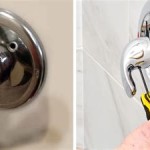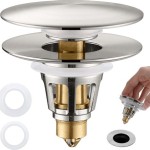Installing PEX for a Bathroom Sink
Installing PEX (cross-linked polyethylene) plumbing for a bathroom sink is a relatively straightforward project that can be tackled by homeowners with basic plumbing skills. PEX tubing offers numerous advantages over traditional copper pipes, including ease of installation, affordability, and corrosion resistance. This article will guide you through the process of installing PEX for a bathroom sink, providing step-by-step instructions and essential tips for a successful installation.
Step 1: Gather Materials and Tools
Before you begin, assemble the necessary materials and tools for your PEX installation. This will ensure a smooth and efficient process. Here's a list of essentials:
- PEX tubing: Determine the required length of PEX tubing for your sink setup, ensuring sufficient extra for connections.
- PEX crimp rings: These rings are essential for securing the connections between PEX tubing and fittings.
- PEX crimp tool: A reliable crimp tool is necessary to create tight and secure connections.
- PEX fittings: These fittings connect the PEX tubing to the sink and the water supply.
- Stop valve: A stop valve allows you to easily shut off the water supply to the sink.
- Pipe cutter: A pipe cutter is used to precisely cut the PEX tubing to the desired length.
- Deburring tool: This tool removes sharp edges from the cut ends of the PEX tubing, preventing damage to the crimp rings and fittings.
- Tape measure: Accurately measure the required lengths of PEX tubing.
- Level: Ensure that the sink and associated plumbing are installed level.
- Adjustable wrench: Use this to tighten the fittings and secure the stop valve.
- Channel locks: These can be useful for gripping and tightening fittings.
- Safety glasses: Protect your eyes during the installation process.
- Gloves: Wear gloves to protect your hands from potential cuts or rough surfaces.
Step 2: Shut Off Water Supply and Drain Existing Plumbing
Before commencing with the new PEX installation, ensure that the water supply to the bathroom sink is completely shut off. Locate the shut-off valve for the sink, typically found beneath the sink or on the wall nearby, and turn it to the "off" position. Once the water supply is shut off, drain the existing plumbing by opening the drain valve beneath the sink.
Step 3: Disconnect Old Plumbing
Carefully disconnect the old plumbing from the sink and the water supply. This involves unscrewing fittings, removing the old pipes, and disconnecting the waste line from the sink. Be sure to disconnect the water supply line from the stop valve as well. In most cases, the old supply lines will likely be made of copper, which can be easily removed with a pipe wrench or a wrench designed for copper pipes.
Step 4: Install PEX Tubing and Fittings
With the old plumbing removed, you can start installing the new PEX tubing and fittings. Start by cutting the PEX tubing to the required lengths for the hot and cold water lines using a pipe cutter. Ensure the cuts are clean and precise to prevent leakages. Next, deburr the cut ends of the PEX tubing using a deburring tool to remove any sharp edges. Then, you can begin assembling the PEX fittings using a reliable crimp tool. Thread the PEX tubing into the fittings, making sure that it's inserted all the way. Place the crimp rings over the tubing, positioning them securely in the space between the fitting and the tubing. Use the crimp tool to press the crimp ring tightly around the tubing, forming a secure and leak-proof connection. Repeat this process to connect the PEX tubing to the fittings on the stop valve and sink.
Step 5: Connect Waste Line
Connect the new waste line to the new sink. Typically, the waste line is connected to a P-trap, a U-shaped section of pipe that traps water to prevent sewer gasses from entering the house. Use a sealant to ensure a tight connection between the waste line and the P-trap, as well as the P-trap and the sink.
Step 6: Install Sink and Secure Fittings
Carefully install the new sink in its designated location. Once the sink is positioned, secure the drain and supply lines using wrenches and ensure that the sink is level and securely fastened to the countertop.
Step 7: Turn On Water Supply and Test for Leaks
After completing the installation, carefully turn on the water supply and test for any leaks. Check all connections for any signs of leakage, and tighten any loose fittings as necessary. Ensure that all connections are secure and leak-free before proceeding to the final step.
Step 8: Clean Up and Finish
Once you've confirmed that there are no leaks, clean up any excess water, debris, or sealant. Dispose of any unused materials properly. Finally, double-check all connections and fittings to ensure that they are secure and leak-free. You may wish to run water through the sink for a few minutes to flush out any remaining debris.

How To Install Pex Pipe A Bathroom Sink Pkb Cabinetry

How To Install Pex And Abs In A Bathroom Diy Plumbing Rework

What You Need To Know About Pex Plumbing Pipe Family Handyman

How To Finish A Basement Bathroom Pex Plumbing

What You Need To Know About Pex Plumbing Pipe Family Handyman

Pin On Master Bath

Pex Plumbing Disadvantages What You Need To Know

Plumber Tips Everything You Need To Know About Pex Piping Granbury Tx Benjamin Franklin Plumbing

Pex Plumbing How To Rough In Supply For Shower

Bathroom Sink Pex Water Line Stub Out Drain Photo Master Bath Shower






